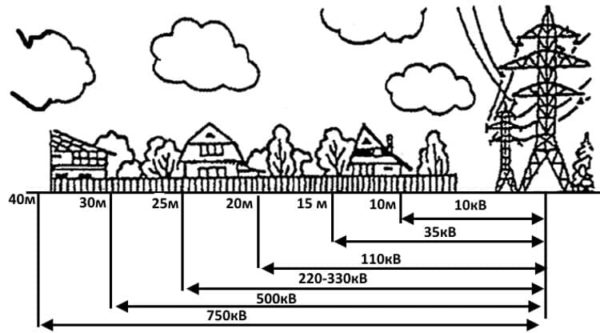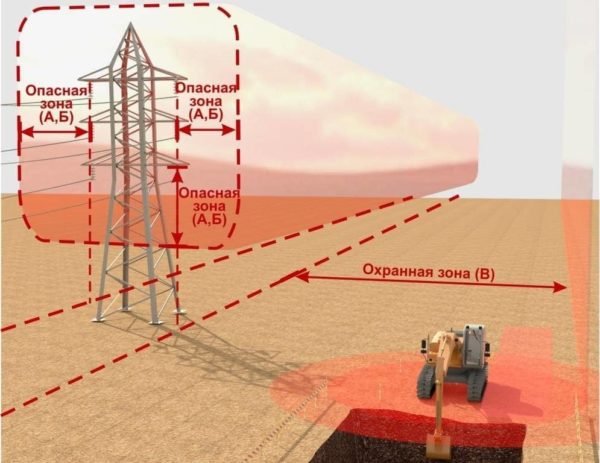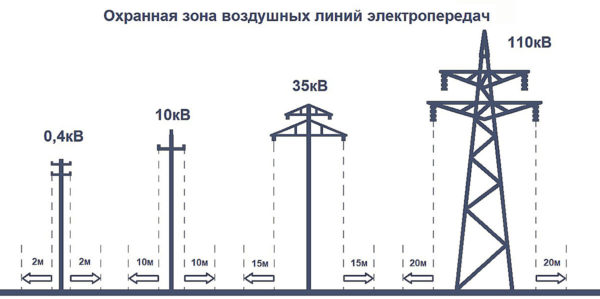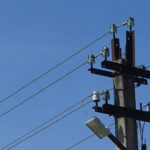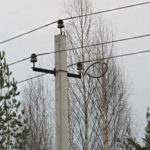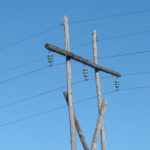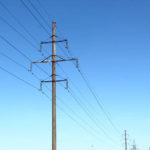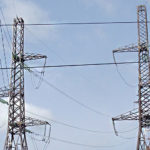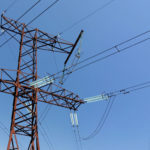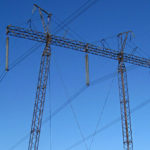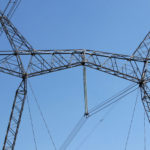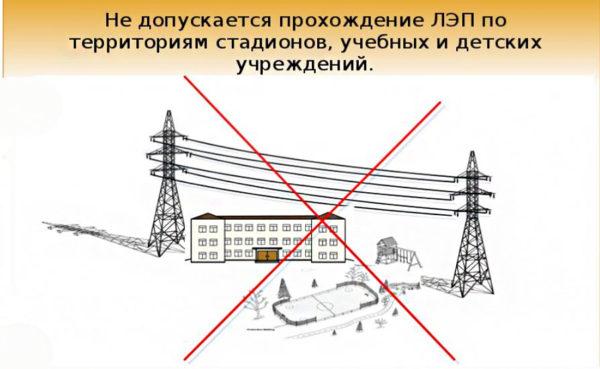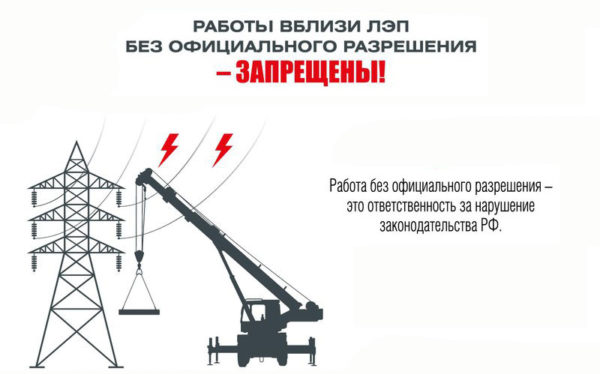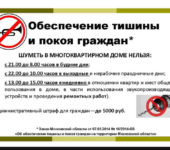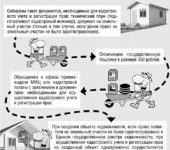Security zone and safe distance from power lines
When a high voltage electric current passes around the conductor, an electromagnetic field harmful to the body is formed. To protect a person from this radiation, the SanPiN standards have been calculated and introduced. They indicate safe distances for living from electric lines to residential buildings, taking into account the voltage in the network. What is a power transmission line security zone, is it possible to carry out construction and work in it, and also how this impact is measured - further in the article.
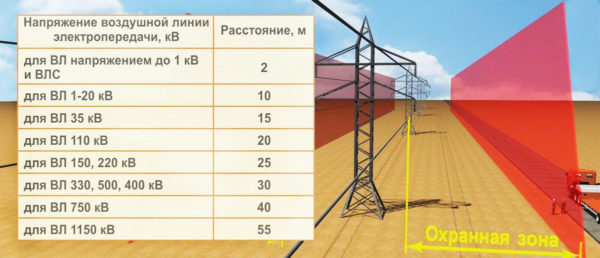
The content of the article
- 1 Consequences of exposure to the electromagnetic field on the human body
- 2 Regulations
- 3 What is a security zone and where is it installed
- 4 Security zone depending on line voltage
- 5 Determine the voltage of the power line by appearance
- 6 How to work in security zones
- 7 What actions are prohibited in the security zone of power lines
- 8 Basic safety rules when you are in the security zone of power lines
Consequences of exposure to the electromagnetic field on the human body
After numerous experiments and observations, it has been proven that:
- Electromagnetic fields induce both potential differences and currents in the human body. Short-term exposure to such values is not hazardous to health, but prolonged exposure to radiation can seriously disrupt the functioning of internal organs.
- A long period under electromagnetic radiation leads to an increase in the temperature of the body - a very doubtful and unproven fact, and today it exists only as a theory.
- Even a weak but long-term radiation from power lines leads to an increase in migraines and headaches, dizziness, sleep disturbances, a constant feeling of fatigue, and incorrect functioning of the entire nervous system.
Research has been carried out in the field of the effect of electromagnetic radiation on the body of pregnant women. Conclusion: an increase in the number of premature births, miscarriages, too low weight of newborn babies. Prolonged exposure to the field is one of the causes of cancer.
The impact on a person of power lines is also characterized by the density of the flux of magnetic induction. This is a value measured in Tesla. For humans, the normal level is 0.2 - 0.3 μT (microTesla), but these are foreign studies that are not accepted in Russia. We do not have a standard for this value.
Important! Knowing the safe distance at which you should be from the line, you can save not only your health, but also your life.
Regulations
The main regulatory document in determining the security zone of a power line is GOST 12.1.051-90, which describes in detail the safe distance. A separate item is devoted to the safety of work in the area of the appearance of an electromagnetic field around power lines.
As for the protection of human health, the SanPiN standards were introduced. With their introduction, construction within the sanitary protection zones of power lines was already prohibited and safe values of electric fields were indicated.
SanPiN 2971-84, which have been in force for quite a long time, have now expired and replaced by a new document SanPiN 2.1.2.1002-00 regulating the development of SNT and IZHS.
What is a security zone and where is it installed
The protection zone of a power transmission line is a conditional plane laid at a certain distance from power lines, the long crossing of which can negatively affect the state of human health.
Features of determining the security zone of power lines in accordance with GOST 12.1.051-90:
- The concept of a security zone includes the space from the power line to the ground.
- The territory with increased danger to the human body is enclosed by two conventional planes running vertically, to the left and right of the power line.
Important! The conventional planes do not pass from the cables themselves, but at a distance from them specified in GOST 12.1.051-90.
- If a power transmission line is laid over a lake, river, or another type of reservoir, then imaginary planes for navigable reservoirs are determined at a distance of 100 m from the line cables, and for non-navigable ones - as well as for the space above the ground.
- Distance from cables for underground power lines is at least 1 m.
- Distance from underwater power lines - 100 m.
Do not confuse the concept of a security zone and an area where there is a high probability of receiving an electric shock. Such a probability is excluded or minimized by strict adherence to the rules for designing power lines, which must be strictly adhered to during the construction of power lines.
Security zone depending on line voltage
GOST 12.1.051-90 determines the distance from the extreme cables of the power transmission line depending on the voltage of the transmission line. On the operating lines, the boundaries of the sanitary protection zones are determined by the criteria for the electric field strength - 1 kV / m.
- Up to 20 kV - 10 m.
- From 20 to 35 kV - 15 m.
- From 35 to 110 kV - 20 m.
- From 110 to 220 kV - 25 m.
- From 220 to 500 kV - 30 m.
- From 500 to 750 kV - 40 m.
- From 750 to 1150 kV - 55 m.
Visually postponing the above given distances from the power transmission line (depending on the line voltage), it is necessary to immediately draw conditional vertical projections on the ground - this will be the border of the security zone. For greater safety and health, you should not be in such areas for a long time. Building under power lines is prohibited.
Determine the voltage of the power line by appearance
If a high-voltage line passes near your house, you can determine its voltage by its appearance. The most common in settlements are the supports of the 0.4 and 10 kilovolt lines.
Supports with voltage up to 0.4 kV also have a security zone equal to 2 meters. Most often, in cities, they are carried out with a self-supporting insulated wire, as well as an aluminum wire on low supports with small white, brown or glass insulators.
Power transmission towers of 10 kV are distinguished by larger brown insulators, and a height of about 9 meters.
Airs - 35, 110 and 220 kV have one wire per phase. 330 kV - 2 wires, 500 kV - 3, and 750 kV - 4 or 5 wires. They also differ in the number of insulators in garlands: 35 kV 3-5 pcs., 110 kV 6-8 pcs., 220 kV 10-15 pcs., 500 kV overhead lines from 20 and 750 kV overhead lines more than 20 pieces.
- Insulators 0.4, 10 and 35 kilovolts
- A support with a voltage of 0.4 kV. Small insulators with 1 wire
- 10 kV pole, larger insulators and thicker wire
- Support with a voltage of 35 kV. 1 wire suspended on 3 insulators
- Support 110 kilovolts. One core on 6-8 insulators
- Supports 220 kV have 1 wire with a suspension on 10-15 insulators
- Support 330 kV, 2 cores are suspended on 14 or more insulators
- 500 kV has 3 cores. More than 20 insulators
- Overhead line 750 kV. Has 4 or 5 wires.
How to work in security zones
Long-term stay in areas close to power lines leads to disruption of the human body, deterioration of well-being and health. The need to carry out any installation or construction work implies the observance of certain safety measures.
Before carrying out work in security zones, all requirements of GOST 12.1.019 must be observed.If it is not possible to turn off the line, it is necessary to give the working personnel protective equipment, install a protective fence, and ensure complete isolation of the workplace.
If there is an increased risk of touching current-carrying parts, a protective earth or grounding of the line must be provided. Measure the insulation resistance with special instruments. Depending on the situation, protective equipment can be used individually or all together.
Necessarily! Before starting work, a safety briefing must be carried out. If necessary, personnel are also tested for their knowledge of basic safety rules or applicable instructions.
Before carrying out earthwork, make sure that there are no high-voltage lines in this place. Very often the excavator becomes the cause of a serious short circuit, in which not only the equipment, but also the health of the excavator himself can suffer.
If your house was built in a protected area, but before the construction of the overhead line, the contractor performing the work must agree on the work to be carried out.
What actions are prohibited in the security zone of power lines
The high voltage under which the power lines are located is a direct threat to the life and health of both operating personnel and bystanders who ignore safety regulations. To minimize accidents, as well as violations of power transmission lines, GOST 12.1.051-90 provides a list of actions that are prohibited from being carried out in the security zone.
In the security zone of power lines of any voltage it is prohibited:
- Construction, major repairs, demolition of buildings or structures.
- Install storage facilities for fuels and lubricants, due to the possibility of unintentional ignition or fire. It is also prohibited to drain spent fuel and lubricants from nearby storage bases into the security zone of the power transmission line.
- Locate landfills or places of large accumulation of both construction and household or industrial waste.
- Build a gas station.
- Carry out work using explosive or flammable substances. And also fire is prohibited.
- It is strictly forbidden to throw conductors on wires of both high and low voltage in order to attempt to steal electricity. This can lead to an accident, and in the case of high voltage power lines, death.
GOST 12.1.051-90 prohibits repair work on overhead power lines during a thunderstorm or rain. If the power line has an important status and by its inaction can disrupt the work of serious industrial or state enterprises, then repair work on it is allowed only when the voltage is removed. When working on overhead lines without contact with conductors, the distance from a person to the nearest cable must be at least two meters.
Working under voltage, with all technical means of protection, is allowed only in two cases: when the water jet is raised no more than 3 meters from the ground or when the water jet does not fall into the security zone of the power transmission line.
In the security zone of power transmission lines, no work is allowed without the permission of the organizations operating them. The list also includes items such as digging land or laying road lines.
A separate item is the use of switch cranes near power lines. The optimal distance at which such equipment can work is at least 30 m. If it is impossible to carry out work without a crane, then this is displayed in the work permit - a special document issued to the crane operator.
Basic safety rules when you are in the security zone of power lines
There are situations when it is not possible to bypass the protection zone of the power transmission line, for example, on rough terrain or close to the power line of reservoirs. In this case, you should adhere to simple safety rules, and, if possible, stay away from the transmission line for a long time.
The wire lying on the ground should never be approached. It is impossible to visually determine whether it is energized or not, therefore, the optimal and safe distance is at least 8 m.If the distance from a person to the cable is less, then you should leave the danger zone as quickly as possible, but in small steps, without taking your feet off the ground, since in this situation, step-by-step tension appears, which can be critical for life or health.
If, when passing through the security zone of an overhead power line, a very sagging wire is noticed, then you cannot move under it. The design of the overhead transmission line provides for its distance from the cables to the ground, taking into account such an important factor as the magnitude of the operating voltage. Therefore, a violation of the distance from the wire to the ground can result in an electric shock.
Before passing through the security zone of the power transmission line, you should visually make sure that there are no line faults. Sparks or short-term arcs mean that the power line is in disrepair and being near it is life-threatening.

